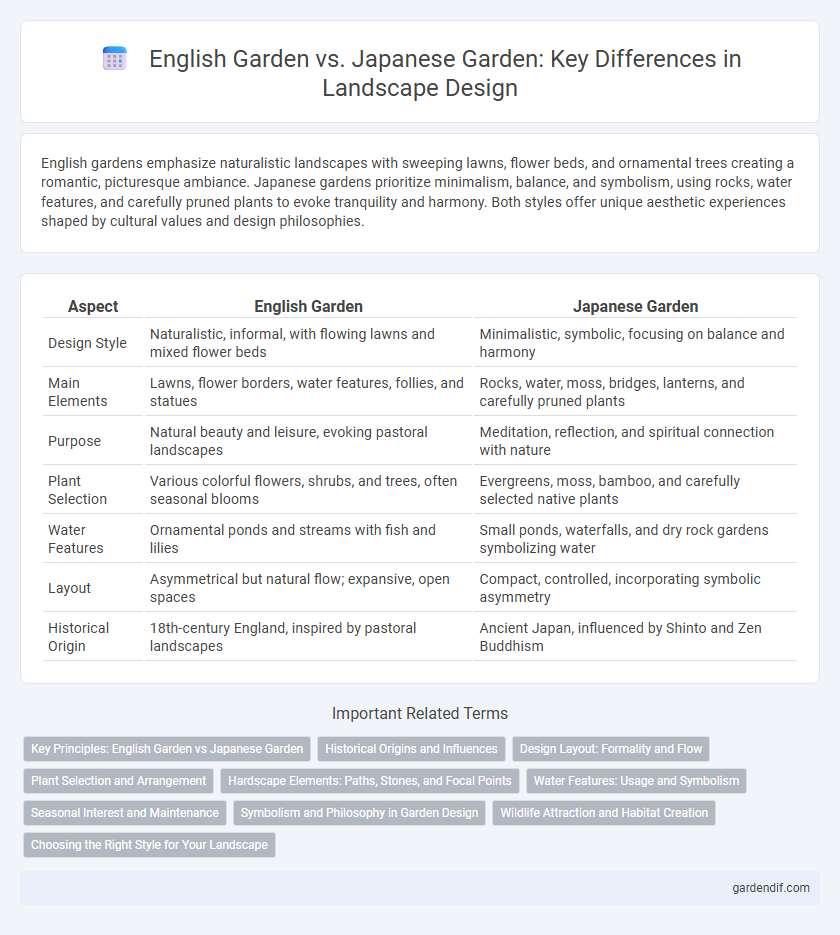
English Garden vs Japanese Garden Illustration
English gardens emphasize naturalistic landscapes with sweeping lawns, flower beds, and ornamental trees creating a romantic, picturesque ambiance. Japanese gardens prioritize minimalism, balance, and symbolism, using rocks, water features, and carefully pruned plants to evoke tranquility and harmony. Both styles offer unique aesthetic experiences shaped by cultural values and design philosophies.
Table of Comparison
| Aspect | English Garden | Japanese Garden |
|---|---|---|
| Design Style | Naturalistic, informal, with flowing lawns and mixed flower beds | Minimalistic, symbolic, focusing on balance and harmony |
| Main Elements | Lawns, flower borders, water features, follies, and statues | Rocks, water, moss, bridges, lanterns, and carefully pruned plants |
| Purpose | Natural beauty and leisure, evoking pastoral landscapes | Meditation, reflection, and spiritual connection with nature |
| Plant Selection | Various colorful flowers, shrubs, and trees, often seasonal blooms | Evergreens, moss, bamboo, and carefully selected native plants |
| Water Features | Ornamental ponds and streams with fish and lilies | Small ponds, waterfalls, and dry rock gardens symbolizing water |
| Layout | Asymmetrical but natural flow; expansive, open spaces | Compact, controlled, incorporating symbolic asymmetry |
| Historical Origin | 18th-century England, inspired by pastoral landscapes | Ancient Japan, influenced by Shinto and Zen Buddhism |
Key Principles: English Garden vs Japanese Garden
English gardens emphasize naturalistic landscapes with informal layouts, curved paths, and a variety of flowering plants to create a picturesque, romantic atmosphere. Japanese gardens focus on minimalism, balance, and symbolism, utilizing elements like rocks, water, and carefully pruned plants to evoke tranquility and harmony with nature. Key design principles contrast the English garden's emphasis on spontaneity and diversity with the Japanese garden's structured simplicity and meditative spaces.
Historical Origins and Influences
English gardens originated in the 18th century as a reaction against formal, symmetrical designs, drawing inspiration from pastoral landscapes and classical art to emphasize natural beauty and informal layouts. Japanese gardens date back over a thousand years, deeply influenced by Shinto, Buddhist, and Taoist philosophies that emphasize harmony, tranquility, and symbolic elements like stones, water, and plants. These distinct historical origins shaped English gardens to celebrate romanticized naturalism while Japanese gardens focus on spiritual reflection and the idealized miniature landscape.
Design Layout: Formality and Flow
English garden design emphasizes informal, naturalistic layouts with winding paths and asymmetrical planting that fosters a sense of organic flow and spontaneity. Japanese garden design prioritizes formal, deliberate arrangements with carefully placed stones, water features, and pruned plants that create a harmonious and meditative flow. The contrast lies in the English garden's casual, free-flowing aesthetic versus the Japanese garden's structured, balanced formality.
Plant Selection and Arrangement
English gardens emphasize lush, diverse plantings with a naturalistic arrangement, incorporating flowering shrubs, perennial borders, and a mix of deciduous and evergreen trees for seasonal interest. Japanese gardens prioritize minimalism and symbolism, using carefully selected plants such as moss, bamboo, azaleas, and maples arranged asymmetrically to evoke tranquility and balance. The contrasting plant selection and spatial composition reflect each garden's cultural values, with English gardens favoring abundance and Japanese gardens emphasizing harmony.
Hardscape Elements: Paths, Stones, and Focal Points
English gardens emphasize winding gravel paths, naturalistic stone arrangements, and prominent focal points like statues or sundials to create a romantic, picturesque atmosphere. Japanese gardens feature minimalist hardscape elements including carefully placed stepping stones, compact gravel or sand raked patterns, and focal points such as lanterns or water basins that symbolize tranquility and balance. The design of paths and stones in each garden style directly reflects their cultural approaches to nature and spatial harmony.
Water Features: Usage and Symbolism
English gardens incorporate water features such as ponds, lakes, and gently flowing streams to create naturalistic landscapes symbolizing tranquility and abundance. Japanese gardens emphasize water elements like koi ponds, waterfalls, and stone basins, representing purity, renewal, and the flow of life. Water in English gardens often serves aesthetic and recreational purposes, while in Japanese gardens it holds deep spiritual and symbolic significance.
Seasonal Interest and Maintenance
English gardens emphasize vibrant seasonal interest with a variety of flowering plants that bloom across spring, summer, and autumn, creating dynamic color changes. Japanese gardens prioritize year-round tranquility through evergreens, moss, and carefully pruned trees that highlight subtle seasonal shifts like cherry blossoms in spring and maples in autumn. Maintenance for English gardens involves regular pruning, deadheading, and lawn care to sustain diverse blooms, while Japanese gardens require meticulous attention to pruning, raking, and seasonal adjustments to preserve their minimalist aesthetic and structural harmony.
Symbolism and Philosophy in Garden Design
English gardens emphasize naturalistic landscapes symbolizing freedom and romanticism, incorporating elements like winding paths and irregular plantings to evoke a pastoral ideal. Japanese gardens prioritize harmony and spiritual reflection, using symbolic features such as rocks, water, and minimalist arrangements to represent balance, impermanence, and Zen philosophy. Both garden styles embody cultural values through purposeful design that transcends mere aesthetics.
Wildlife Attraction and Habitat Creation
English gardens emphasize diverse plant species and open lawns, creating rich habitats that attract a variety of birds, butterflies, and small mammals. Japanese gardens prioritize natural elements such as water features, rocks, and native plants, fostering calm environments that support amphibians, koi fish, and insects. Both garden styles contribute uniquely to wildlife attraction and habitat creation by blending aesthetics with ecological function.
Choosing the Right Style for Your Landscape
English gardens emphasize naturalistic design with rolling lawns, colorful flower beds, and informal layouts promoting a romantic and serene atmosphere. Japanese gardens prioritize minimalism, asymmetry, and symbolic elements such as koi ponds, stone lanterns, and bonsai trees to create a tranquil and meditative space. Selecting the right style depends on your landscape's size, climate, maintenance preferences, and desired emotional impact, balancing cultural aesthetics with practical considerations.
English Garden vs Japanese Garden Infographic

 gardendif.com
gardendif.com